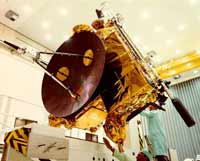European Space Agency ends one of its longest and most unique projects
The European Space Agency is expected to make an announcement to shut down the Ulysses project. Ulysses is a little-known, albeit a unique robotic space probe that was designed to study the Sun at all latitudes.

The probe was launched in 1990. It is still up and running and is still capable of establishing connections with Earth. However, the ESA decided to close the project.
Ulysses has proved to be both successful and unfortunate. To send the probe to the Sun scientists initially decided to aim it to Jupiter. Ulysses needed to reach the largest planet of the solar system to develop the necessary speed and change its course. Jupiter’s gravity was thought to accelerate the probe, change its orbit and send the station back to the Sun.
The space probe was named after Ulysses (Odysseus), one of the most unfortunate characters of Greek mythology. The launch was the probe was delayed 25 years ago, when NASA started to develop its shuttle program. The budget of the International Solar Polar Mission was cut.
When Space Shuttle Challenger exploded in January of 1986, the launch of Ulysses was delayed again, this time indefinitely. The probe was eventually launched only in October 1990 when space shuttles started flying again.
The spacecraft was designed to withstand both the heat of the inner solar system and the cold at Jupiter distance. Extensive blanketing and electric heaters protect against cold. Heating is minimized by the 1.3 AU perihelion, meaning that Ulysses always studies the Sun from a greater distance than the Earth.
The space probe successfully reached Jupiter and headed towards the Sun. The spacecraft flew above the southern pole of the Sun in the fall of 1994, orbited the star and reached the northern pole a year later.
Ulysses was supposed to end its existence, since the program was developed only for five years. However, the spacecraft was functioning normally, and European scientists decided to continue their observations. Ulysses orbited the Sun again in 2000-2001.
During cruise phases, Ulysses is still providing unique data. As the only spacecraft out of the ecliptic with a gamma-ray instrument, Ulysses provides an important part of the InterPlanetary Network (IPN). The IPN detects gamma ray bursts (GRBs); since gamma rays cannot be focused with mirrors, it was very difficult to locate GRBs with enough accuracy to study them further. Instead, several spacecraft can locate the burst through triangulation (or, more specifically, multilateration). Each spacecraft has a gamma-ray detector, with readouts noted in tiny fractions of a second. By comparing the arrival times of gamma showers with the separations of the spacecraft, a location can be determined, for follow-up with other telescopes. Because gamma rays travel at the speed of light, wide separations are needed. Typically, a determination comes from comparing: one of several spacecraft orbiting the Earth, an inner-Solar-system probe (to Mars, Venus, or an asteroid), and Ulysses. When Ulysses crosses the ecliptic twice per orbit, many GRB determinations lose accuracy.
The project will finally be closed after 17 years of successful operation.
Vremya Novostei
Subscribe to Pravda.Ru Telegram channel, Facebook, RSS!

